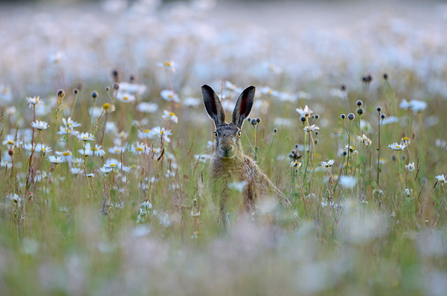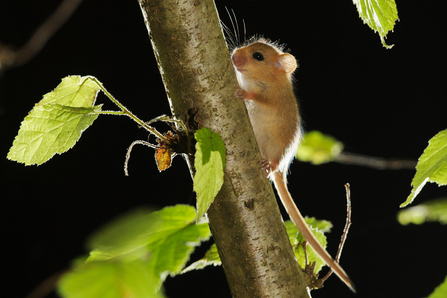
David Tipling/2020VISION
Floods at Duxford Old River. Photo: Simon Cousins

David Tipling/2020VISION
Like me, you may have noticed strange things happening to our local nature in the past few years. Plants are blooming at odd times of the year; trees and shrubs are dying unexpectedly; some species of birds seem to be on the increase, but others are becoming scarcer.
In my corner of East Berkshire, I watched temperatures exceed 39°C in 2022; wildfires destroyed rare heathland habitat in a nearby national nature reserve; and flooding and strong winds this winter have downed trees and flooded homes and gardens. Climate change is here, and it is affecting us in Berkshire, Buckinghamshire and Oxfordshire, as well as globally.
You can find the statistics for what is happening in the annual State of the UK Climate report. Locally, our average temperatures have increased by over 1°C compared to the average from 1961 to 1990. Extreme temperatures exceeded +1.5°C in some locations in 2022. Our average rainfall has not changed significantly, but we are seeing greater extremes of drought, then flood.
Globally, records were broken across the board in 2023 and we’ve observed a big jump in global temperature compared to even the previous record in 2022. This is extremely worrying, but not surprising. Global greenhouse gas emissions are still increasing, despite decades of international diplomacy to try to bring them down.
What this means for wildlife is hard to predict, but we can see indications. BBOWT published research in 2021 that highlighted threats to species such as dormice, beech trees, and blue tits. Plants and animals can struggle to find food and water in very hot or cold weather. The timing of birds nesting and available food supply for their chicks is becoming more unpredictable, while warm spells in winter are disrupting hibernation patterns. Very sadly, last year volunteers found just two dormice across the Trust’s reserves, compared to over 100 back in 2004. Climate change is thought to be part of the reason for the huge decline.

Dormice are in decline © Terry Whittaker/2020VISION
I joined The Wildlife Trusts in 2021 from a 20-year career in government working on climate change adaptation (building resilience) and mitigation (reducing emissions). One of my first major projects was to publish a climate change risk assessment and adaptation plan for the next five years for all of The Wildlife Trusts. Changing Nature was released in 2022 and highlights the work we are doing to protect our wildlife and wild spaces from the impacts of climate change. However, it also looks at how nature can help us to tackle climate change itself.
The climate and nature crises are so closely interlinked that we cannot address one without the other. We need to let nature help us to reduce climate change and its impacts, as well as protect nature as much as possible. Particularly in the case of building resilience to climate change, it is local action that matters the most.
BBOWT is doing incredible work to make this a reality. We can see how important nature is for tackling climate change in our local communities through some of the Trust’s flagship projects. One example is Chimney Meadows, which is acting to soak up water during times of flood, protecting communities further downstream along the Thames. The site as a whole has started to store carbon, rather than emitting it.
Vote for climate - Lisa Lane, Living Landscape Manager
We are also prioritising nature-based solutions across the whole Wildlife Trust movement. It is one of the three key goals in our collective 2030 Strategy, and we know what works. Across the country, Wildlife Trusts are investing in projects to manage flood water, reduce urban temperatures, soak up carbon in woodlands and peatlands, and improve soil health, as well as restore and protect habitats and improve connectivity so that wildlife can move more easily.
Last year, we published a showcase of just 30 of our hundreds of nature-based solutions projects, with these alone totalling more than £75 million of investment. The Wildlife Trusts are a major player in delivering change on the ground to help tackle climate change, but we need much more of it! The latest figures provided to the government suggest more than £3 billion is needed each year this decade for nature restoration to address climate change impacts.
Every bit of additional action matters in reducing the effects of climate change. You can help by donating to BBOWT’s Nature Recovery Fund to give the resources and firepower necessary to make it happen.
Nature can lock up carbon while offering a host of other benefits such as flood alleviation, as Head of Ecology Debbie Lewis explains.
In 2017, BBOWT carried out a detailed assessment of the ecosystem service benefits provided by Chimney Meadows, by comparing the land to what it would have been like had the Trust not converted it from an arable farm to a nature reserve.
The findings showed that the creation of 79 hectares of flower-rich meadows on previously cropped fields has resulted in 466 tonnes of carbon dioxide or its equivalent being drawn down and locked up every year. The research also showed that the created wetland habitats at Chimney provide flood risk regulation benefits in the region of £60,000 annually.
Together with the Floodplain Meadows Partnership and the Thames Valley Wildflower Meadows Restoration Project, BBOWT has been looking further into the carbon storage capacity of species-rich floodplain meadows. This three-year project was funded by Ecover and aimed to investigate the carbon storage capacities of arable fields in comparison to newly restored meadows, meadows restored more than 10 years ago, and ancient wildflower meadows.
Fieldwork finished at the end of last summer and scientists at the Open University are analysing the data to see what it tells us. Preliminary results suggest that ancient meadows store 60% more carbon than arable fields.
Ask your candidates in the general election what their parties are doing to address The Wildlife Trusts' priorities and what they will do locally to tackle climate change if elected. Whichever way you vote on 4 July, remember to vote for nature